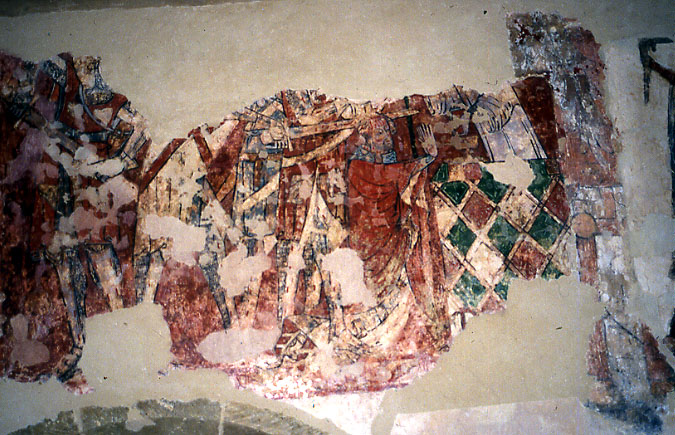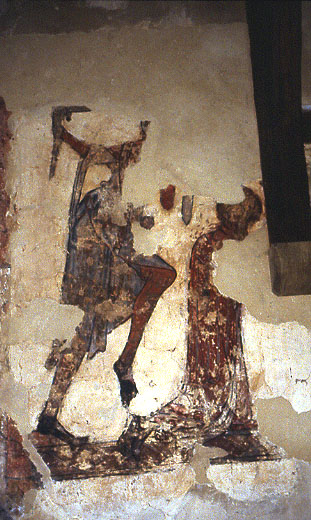South Newington, Oxfordshire (†Oxford) c.1330-1340
Murder of St Thomas Becket
Execution of Thomas of Lancaster

The painting of the murder of Becket is badly damaged, but it remains one of the finest medieval wall paintings in England. As with all the fourteenth century work at South Newington, it is painted in oil, probably, as Tristram speculated, an emulsion of oil with some other medium such as egg tempera.
This unusual choice of materials, more often found in manuscript painting, but far from common even there, is testimony to the considerable expertise of the painter. Reading from the extreme right, an outstretched arm and hand with part of a sword is the edge of a painting of the Beheading of Thomas of Lancaster (see below). Immediately to the left of this is a vertical strip of painting which belongs, I think, to an earlier subject – there is something that might be the end of an angel’s wing in the upper part of the strip, with, below, some rectilinear details suggesting a construction or framework of some kind. Then comes the murder of Becket, with, furthest right, an altar covered with an elaborate red-and-green cloth in a trellis pattern.
Behind the altar is what is left of the figure of Edward Grim, Becket’s chaplain, dressed in a white alb. He holds a book and his right arm is extended across the altar, on which stands a chalice. He is probably trying to fend off the first blow, as accounts of the murder claim that he did.

Thomas, fortunately clear although he tends to merge with the background now, kneels before the altar, hands extended in prayer. He is vested for Mass and the sword that struck his head is still embedded in it. This sword is held by a knight in a blue surcoat standing just left of centre; Reginald Fitzurse, said to have been the first to strike, has evidently already done so. Fitzurse, standing directly behind Thomas, can be identified by the heraldic punning bear on his surcoat. This is rather indefinite now, but the standing (heraldically statant) bear is facing to the right, on all fours with head lowered, directly below Fitzurse’s sword-belt. Its body is now effectively bisected at mid-torso by a sharply tapering spear-like area of plaster where pigment has gone.

The remaining two knights are further left, the second from the far left wearing a light yellow ochre surcoat, and the other, the most nearly complete of the four, at the extreme left (detail, right), shown in the act of drawing his sword. Sizeable areas of him are missing, but his legs, his right arm and hand drawing his sword, his bent left arm and hand steadying his scabbard and most of his head with its chain-mail coif are all visible.

Had Henry VIII of England, who ordered all images of and references to Becket expunged from his realm, known about this painting he would of course have had it destroyed. Had he known about its companion piece, the Execution of Thomas of Lancaster, another political rebel against his king, he would have been still further incensed. Thomas, Earl of Lancaster was beheaded within sight of his own castle at Pontefract in 1321 for leading the rebellion of the northern earls against Edward 11, and only his royal blood saved him from the full horror of a traitor’s death. The painting of his execution is below at the left, and the juxtaposition of it with the murder of Becket must surely be deliberate. Lancaster kneels at the right, in an attitude very similar to Becket’s own, while the executioner at the left raises his sword for the death-stroke.
The connection between the two extends further than a mere coincidence of Christian names. Lancaster was buried close to the high altar of the Cluniac priory at Pontefract, and miracles were reported at his tomb. Calls for his beatification, all of them unsuccessful despite the appellation ‘Blessed’ regularly bestowed on him, soon followed and in 1343 a chantry, dedicated to St Thomas¹ was built and a licence for masses to be said there obtained.
Later chroniclers and historians were far less sympathetic to Lancaster, seeing him as a selfish and devious man who deserved his fate, but the connection between his life and death and those of Thomas Becket was, on the evidence of the South Newington paintings, established in some medieval minds at least Mention has been made on the page for the Virgin & Child at South Newington of Thomas Giffard and his wife, who may have commissioned these paintings, and it might well be that Thomas Giffard regarded both Becket and Lancaster as his saintly patrons – one formally canonised, the other confidently expected to be.
South Newington is rich in paintings; the Annunciation is also on the site, along with St Margaret and the Dragon and a very interesting 15th century Passion Cycle.
Website for St Peter ad Vincula, South Newington
¹ Whether to Thomas Becket himself, or St Thomas the Apostle I am not certain.